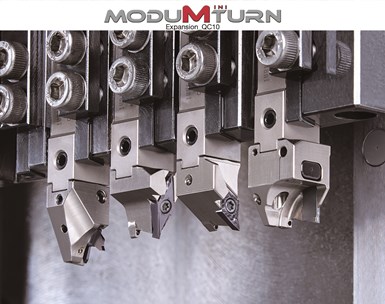Tungaloy-NTK Swiss Turning System Provides High Repeatability
The ModuMiniTurn modular turning tool system provides exceptional repeating accuracy for the cutting point when swapping out modular heads for new inserts.
Tungaloy-NTK America Inc.’s ModuMiniTurn modular turning tool system for Swiss machines now offers QC10 series featuring 10 × 10 mm square shanks.
The ModuMiniTurn modular turning tool system incorporates an advanced coupling mechanism between the modular head and tool shank, providing exceptional repeating accuracy for the cutting point when swapping out modular heads for new inserts. This system achieves repeatability accuracy within the 5 μm range, minimizing downtime during tooling changeovers.
The QC10 series incorporates 10 × 10 mm square shanks that are ideal for use in mini lathes and Swiss machines with smaller footprints that typically carry downsized tool posts. Additionally, QC10 provides a secure coupling between the modular head and shank. According to the company, the tool is designed to guarantees tool stability and high cutting-edge repeatability, resulting in significant time savings during tool changeovers.
The QC10 series offers an extensive selection of modular heads for applications including forward turning, back turning, grooving, parting and thread turning. All modular heads have an internal coolant channel designed to deliver high-pressure coolant close to the cutting point to improve chip control and extend tool life.
Related Content
-
Broaching Tool Technology For Lathes Used to Slot Inconel Parts
This shop finds value in using an indexable-insert-style broaching tool to create blind-hole slots in heat-treated Inconel aerospace parts on a CNC lathe.
-
The Ins and Outs of Inserts
Understanding how inserts are made provides valuable insight into how their performance can be optimized.
-
Starting Small with Automation
Quick-change workholding and flexible robotic automation started this small shop on the path to success.












.png;maxWidth=300;quality=90)

